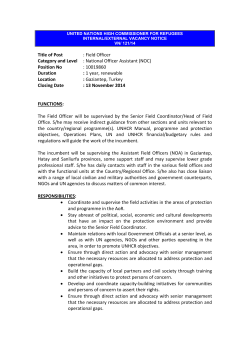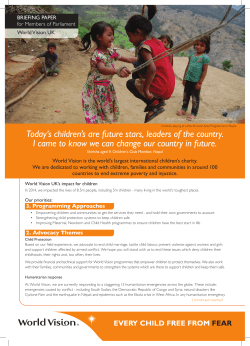
GA Committee 4 Security of Medical Food Aid in Armed Conflicts
YMCA Youth & Government Model United Nations General Assembly TOPIC PREPARATION GUIDE A/15/TPG/4 Distr.: General March 2015 Original: English Special Political and Decolonization Committee: Security of Medical/Food aid in armed conflicts Section 1 Topic Background 1.1 Access to food has been established as a basic human right in several international agreements including the Universal Declaration of Human Rights, and the International Covenant on Economic, Social and Cultural Rights. As a result, nations have the obligation to provide for “availability of food in quantity and quality sufficient to satisfy the dietary needs of individuals, free from adverse substances and acceptable within a given culture”1 1.2 In Afghanistan, Taliban forces have obstructed food and medicinal aid on numerous occasions. The forces of the Northern Alliance have routinely looted food deliveries directed to camps for refugees and internally displaced persons whose survival is dependent upon aid 1.3 Additionally, US (and other nation) led airstrikes have led civilians to flee major cities to areas which are less accessible to food delivery. 1.4 Lack of access to food and medical supplies has been cause for numerous uprisings. Around 2008, world food prices rose rapidly, causing demonstrations in many countries around the world. The reduction of food subsidies in several Arab countries, for example, has been identified as a contributing factor to the unrest of the Arab Spring. 1.5 Annually, billions of dollars in humanitarian relief are sent to African nations yet most of these countries have seen no improvement in living conditions. http://fee.org/freeman/detail/the-sorry-record-of-foreign-aid-in-africa 1.6 In many countries aid is diverted away from relief programs and goes directly to the government. In Ethiopia, the Government used foreign aid to purchase firearms.2 1 6 General Comment 12 of the Committee on Economic, Social and Cultural Rights (ESCR Committee), U.N. Doc. E/C.12/1999/5. 2 New York Times, March 21, 1984, cited in Bovard. Also see David Osterfeld, Prosperity versus Planning(New York: Oxford University Press, 1992), p. 143. A/15/TPG/4 Section 2 Past International Action 2.1 Four United Nations entities -- UNDP, UNHCR, UNICEF and WFP -- have primary roles in the delivery of relief assistance. 2.2 The United Nations Development Programme (UNDP) is the agency responsible for operational activities for natural disaster mitigation, prevention and preparedness. When emergencies and natural disasters occur, UNDP Resident Representatives coordinate relief and rehabilitation efforts at the national level. On many occasions, Governments call on UNDP to help design rehabilitation programmes and to direct donor aid. 2.3 The United Nations Children's Fund (UNICEF) has sought to meet their needs by supplying food, safe water, medicine and shelter. UNICEF has drawn world attention to the plight of children in war. Since 1987, some 2 million children have been killed, 6 million have been seriously injured or disabled, and thousands have fought in armed conflicts. The SecretaryGeneral appointed in 1997 a Special Representative for Children in Armed Conflict to strengthen the protection of children in conflict situations. 2.4 The Office of the United Nations High Commissioner for Refugees (UNHCR) provided international protection and assistance to more than 22 million people who had fled war or persecution, of whom some 12 million were refugees and some 4.4 million were internally displaced perons. Recently, internal conflicts have been the main cause of refugee crises. As of end-1997, UNHCR assisted 2.6 million refugees from Afghanistan, 631,000 from Iraq, 525,000 from Somalia, 517,000 from Burundi and 487,000 from Liberia. Although UNHCR's mandate is to protect and assist refugees, it has been called upon more and more to come to the aid of a wider range of people living in refugee-like situations. In recent years, the distinction between refugees and displaced persons (those who have not crossed international borders) has become increasingly blurred, with the number of people displaced within their own country -- the "internally displaced" -- overtaking the number of refugees. 2.5 In 2000 the UN Security Council adopted a resolution in which it called upon nations and armed combatants to ““ensure the safety, security and freedom of movement” of humanitarian relief workers.126 Section 3 Guiding Questions 2 A/15/TPG/4 • How can the General Assembly (GA) create an enabling environment for the successful provision of humanitarian aid in conflict situations under its purview? • Considering the reciprocal relationship between food insecurity and conflict, how can the GA’s help end the cycle of violence over the control of humanitarian relief? Section 4 Further reading Sam Adelsberg, Freya Pitts, & Sirine Shebaya, Chilling Effect of the Material Support Law on Humanitarian Aid: Causes, Consequences, and Proposed Reforms, 4 Harvard National Security Journal, pp. 282-319 (2012-2013). Charity & Security Network, Safeguarding Humanitarianism in Armed Conflict: A Call for Reconciling International Legal Obligations and Counterterrorism Measures in the United States(2012). Justin A. Fraterman, “Criminalizing Humanitarian Relief: Are U.S. Material Support for Terrorism Laws Compatible with International Humanitarian Law?,” New York University Journal of International Law and Politics, Vol. 46, pp. 399–470 (Spring 2014). 3
© Copyright 2025





















